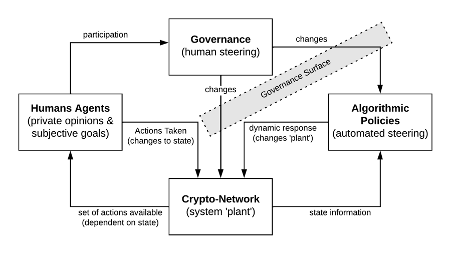A research paper…
Kelsie Nabben, providing a brief introduction to:
Zargham, Michael and Nabben, Kelsie, Aligning ‘Decentralized Autonomous Organization’ to Precedents in Cybernetics (April 4, 2022). Available at SSRN: https://papers.ssrn.com/sol3/papers.cfm?abstract_id=4077358
When I first came across the fact that the term “Decentralized Autonomous Organization” had existed at least since 1997 in my research, I was stunned. Where? Why? And why is no one talking about this?
It turns out that a German computer scientist had used the phrase Decentralized Autonomous Organization” to describe an “intelligent” home system that operated like an immune system in “identifying, defining, and maintaining the self” to “cooperate with other agents by sending messages and interpreting incoming messages such that the whole system fulfils the task it is designed for” (Dilger, 1997).
This approach to thinking about purpose oriented, self-organizing, multi-agent systems comes out of the field of Cybernetics. The term cybernetics stems from the Greek word “kubernetes” meaning “steersman” or “governor”. It is a science of computational augmentation and organization, out of which Information Theory, Control Theory and Control Systems Engineering grew into independent disciplines (Heylighen and Joslyn, 2001).
So, are the principles of control theory and multi-agent, purpose driven organization systems relevant to blockchain technology and communities today? Well, Michael Zargham from BlockScience claims that Web3.0 is the “re-birth of cybernetics”.

To further explore how cybernetic principles apply to decentralized governance, Zargham and I co-wrote a paper (which I’m grateful to have had the opportunity to participate in). The abstract and link are as follows:
Abstract:
“The concept of “Decentralized Autonomous Organization” has been popularized as part of the “Web 3.0” movement. This movement is characterized by digital infrastructures that are ‘decentralized’ in network architecture and permissionless to use. Decentralized autonomous organizations, referred to as DAOs, are a digital expression of the political will to self-organize. The granular entanglement of social and technical concepts makes it challenging to identify a historical precedent for DAOs. Yet, literature review and analysis reveals that this particular entanglement of information systems and self-organization is consistent with longstanding conceptual development and practice in the field of cybernetics. Drawing on Stafford Beer’s Viable Systems Model, this piece bridges DAOs and cybernetics via two main principles of organization: viability and purpose. Viability is a property of a system such that it has sufficient adaptive capacity to thrive in the face of change; adaptive capacity is characterized according to Ross Ashby’s concept of ‘variety’. Purpose is the ability to define and collectively pursue a goal in the sense of feedback control systems. Building on the control theoretic concepts of observability, controllability, and reachability, we examine the ‘governance surface’ of an organization and the associated trade-offs between resilience and robustness that emerge in governance surface design. We propose that this trade-off can be addressed with a constitutional archetype whereby an organization’s ability to update its code is constrained but not eliminated. A case study from a DAO known as ‘1Hive’ is explored to demonstrate this archetype in action. We consider the limitations of the cybernetics perspective by emphasizing the subjectivity of the governance designer. Finally, we conclude with future research directions.”
What I found particularly interesting in this exploration is the increasing relevance of ethnography as a second-order feedback loop in the design and maintenance of systems.
To read the working draft, see:
Zargham, Michael and Nabben, Kelsie, Aligning ‘Decentralized Autonomous Organization’ to Precedents in Cybernetics (April 4, 2022). Available at SSRN: https://papers.ssrn.com/sol3/papers.cfm?abstract_id=4077358
Acknowledgments:
With a massive thanks to the team at BlockScience for contributions and feedback, include Jamsheed Shorish, David Sisson, Danilo Lessa Bernardineli, and Jessica Zartler.


